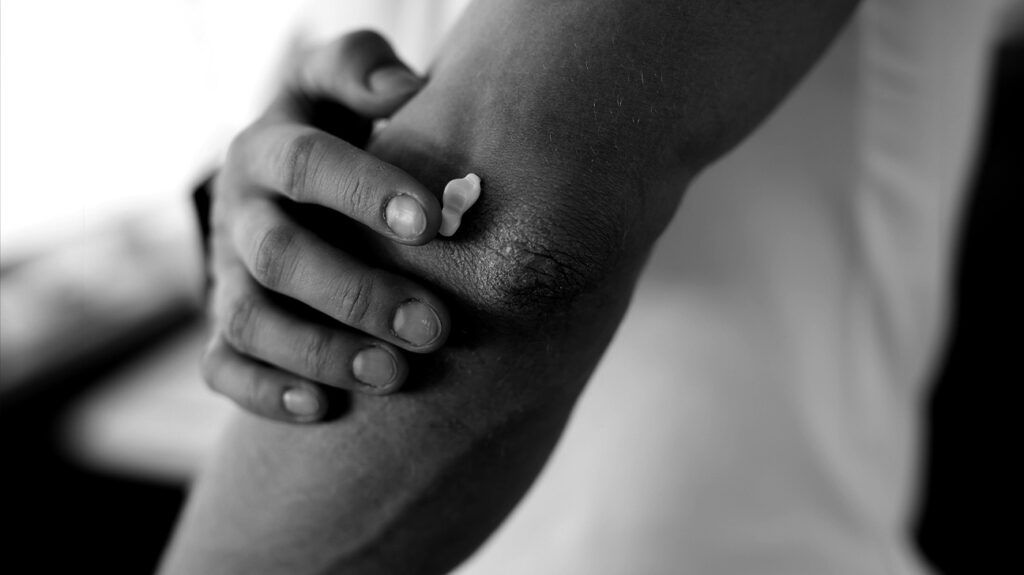Salicylic acid may reduce both the appearance and symptoms of psoriasis. It can exfoliate the skin and, therefore, may help remove psoriasis scales. Salicylic acid is also anti-inflammatory.
Salicylic acid is a topical treatment for psoriasis that comes from willow bark. It softens and removes the excessive buildup of dead skin cells caused by psoriasis by breaking down keratin, a protein that forms part of the skin’s structure.
This article looks at salicylic acid for psoriasis, its effectiveness, and how to use it.

Salicylic acid may help reduce the symptoms of psoriasis by removing dead skin cells and flakes from plaques. People can use it alone or in combination with other treatments, such as topical corticosteroids. In fact, salicylic acid
Few studies have looked at how effective salicylic acid is on its own, but scientists have studied its effectiveness with other therapies.
For example, a small 2022 study examined the effects of a treatment regimen that included a 3% salicylic acid and turmeric gel, followed by a shea butter and salicylic acid moisturizer.
This regimen significantly reduced symptoms such as scaling and redness after
However, this was a small study involving only 20 people, most of whom were white and female. Larger-scale studies in a more diverse population would help to confirm whether this treatment could be an effective way to manage psoriasis.
Salicylic acid has keratolytic properties, which means it can break down the glue-like substance between skin cells. This breaks up excess dead skin and removes it, revealing smoother skin underneath.
Salicylic acid is also anti-inflammatory. As psoriasis is an inflammatory skin condition, this ingredient may help reduce other symptoms, such as itchiness.
By removing the outer layer of dead skin, salicylic acid can also improve the effectiveness of other treatments by enhancing absorption.
The concentration of salicylic acid produced typically ranges from
For example, those who have a reaction to salicylic acid may need to use a milder formulation. Salicylic acid is also not suitable for use around the eyes or mucous membranes, so a person may need another treatment for symptoms in these areas.
People considering this treatment should speak with a doctor about whether salicylic acid is safe for them to use and what the right strength is for them.
When using salicylic acid for psoriasis, it is important for people to follow a healthcare professional’s guidance. They will need to consider:
- the location of the plaques
- their severity
- other treatments a person is using for psoriasis
Some other treatments
A doctor can advise someone when to use salicylic acid in their routine for the best effect. They may recommend salicylic acid in the form of a gel, cream, shampoo, or medicated wipe.
When starting to use salicylic acid:
- Begin by applying a small amount to a limited area to see how the skin reacts. This is known as a patch test.
- If there is no adverse reaction, apply a small amount of salicylic acid to psoriatic plaques. A doctor may advise gradually increasing the strength or frequency of applications to determine the best routine.
- Follow salicylic acid with a moisturizer.
- Look out for signs of irritation, excessive dryness, or adverse reactions. Discontinue use if there are signs of irritation or discomfort.
Always apply sunscreen before going outside while using salicylic acid. This ingredient can make the skin more sensitive to UV damage.
A person should not apply salicylic acid to the eye area, genitals, or mucous membranes unless a healthcare professional advises them to do so.
While salicylic acid is generally safe for most people, it can cause side effects, especially if a person uses it excessively.
Possible side effects include skin irritation and peeling. In rare cases, very excessive use can lead to
Salicylic acid can also weaken hair shafts on the scalp, making them more likely to break. This may lead to temporary hair loss in some people.
If a person notices any adverse effects while using salicylic acid, they should stop using it and seek advice from a doctor.
Below are answers to some common questions about salicylic acid for psoriasis.
Can salicylic acid make psoriasis worse?
Salicylic acid may cause irritation if a person leaves it on the skin for too long or uses it at too high a strength. This could worsen psoriasis symptoms, but it is unclear how common or uncommon this is.
How long does salicylic acid take to work?
Everyone’s skin is different. Therefore, the time it takes for salicylic acid to improve psoriasis symptoms may vary. Some people may experience a reduction in scaling after a few uses, but others may need longer.
Consistently using salicylic acid according to a doctor’s instructions can allow this treatment time to work.
Salicylic acid for psoriasis can help soften the skin and reduce scaling. Its anti-inflammatory properties may also help relieve itchiness.
While effective, people must use the correct concentration of salicylic acid for them and make sure it does not interact with other psoriasis treatments.
Consulting with a healthcare professional can ensure that the treatment is appropriate, safe, and effective for the individual.
